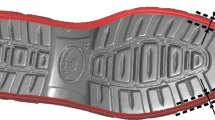Abstract
This paper presents a new method for planar development of the 3D surfaces of a shoe upper. The 3D surface is first faceted into triangular elements and then roughly laid down on a 2D plane. Next, the nodal points of elements are repositioned by a refinement technique that minimizes the geometric errors. Even after elements have been refined by minimizing geometric errors, the resulting 2D shape still has some strain energy that needs to be reduced by a relaxation process. Hence, these elements are then used as an initial guess for further optimization during which the finite element inverse method is used to minimize the total strain energy. In fact, the two-step optimization technique not only can prevent the divergence of solutions (e.g., interferences between elements) but also yields a more reliable result. The method has been implemented as a module of the shoe design system by which a prototype shoe can be designed and manufactured more precisely and quickly.
Similar content being viewed by others
References
K. Lee, Principles of CAD/CAM/CAE Systems, Addison Wesley, (1999).
B. K. Hinds, J. McCartney and G. Woods, Pattern development for 3D surfaces, Computer Aided Design 23(8) (1991) 583–592.
P. Azariadis and N. Aspragathos, Design of plane developments of doubly curved surfaces, Computer Aided Design 29(10) (1997) 675–685.
P. Azariadis, A. Nearchou and N. Aspragathos, An evolutionary algorithm for generating planar developments of arbitrarily curved surfaces, Computers in Industry 47(3) (2002) 357–368.
J. Maillot, H. Yashia and A. Verroust, Interactive texture mapping, Proc SIGGRAPH 93, Anaheim, CA, USA, (1993) 27–34.
G. Elber, Model fabrication using surface layout projection, Computer Aided Design 27(4) (1995) 283–291.
J. Hoschek, Approximation of surfaces of revolution by developable surfaces, Computer Aided Design 30(10) (1998) 757–763.
R. M. C. Bodduluri and B. Ravani, Design of developable surfaces using duality between plane and point geometries, Computer Aided Design 25(10) (1993) 621–632.
T. Shimada and Y. Tada, Approximate transformation of an arbitrary curved surface into a plane using dynamic programming, Computer Aided Design 23(2) (1991) 153–159.
J. Fan, Q. Wang, S. Chen, M. Yuen and C. Chan, A Spring-Mass Model-Based Approach for Warping Cloth Patterns on 3D Objects, Journal of Visualization and Computer Animation 9(4) (1998) 215–227.
C. Wang, S. Smith and M. Yuen, Surface flattening based on energy model, Computer Aided Design 34 (2002) 823–833.
K. Chung and O. Richmond, Ideal forming, part I: homogeneous deformation with minimum plastic work, International Journal of Mechanical Sciences 34 (1992) 575–591.
K. Chung and O. Richmond, Ideal forming, part II: sheet forming with optimum deformation, International Journal of the Mechanical Sciences 34 (1992) 617–633.
K. Chung, J. W. Yoon and O. Richmond, Ideal sheet forming with frictional constraints, International Journal of Plasticity 16 (2000) 595–610.
Y. Q. Guo, J. L. Batoz and J. M. Duroux, Finite element procedures for strain estimation of sheet metal forming parts, International Journal for Numerical Methods in Engineering (8) (1990) 1385–1401.
S. H. Kim and H. Hub H., Finite element inverse analysis for the design of intermediate dies in multistage deep drawing processes with large aspect ratio, Journal of Materials Processing Technology 113 (2001) 779–785.
J. W. Yoon, K. Chung, F. Pourboghrat and F. Barlat, Design optimization of extruded perform for hydroforming processes based on ideal forming design theory, International Journal of Mechanical Sciences 48 (2006) 1416–1428.
E. Horowitz and S. Sahni, Fundamentals of Data Structure, Computer Science Press, (1983).
J. D. Faires and R. L. Burden, Numerical Methods, International Thomson Publishing, (1996).
K. S. Kundert and V. Sangiovanni, A Sparse User’s Guide A Sparse Linear Equation Solver, Dept. of Electrical Engineering and Computer Sciences, U.C. Berkeley, (1998).
K. Chung, and O. O. Richmond, A deformation theory of plasticity based on minimum work paths, International Journal of Plasticity 9 (1993) 907–920.
R. Hill, The Mathematical theory of plasticity, Clarendon Press, (1950).
Author information
Authors and Affiliations
Corresponding author
Rights and permissions
About this article
Cite this article
Chung, W., Kim, SH. & Shin, KH. A method for planar development of 3D surfaces in shoe pattern design. J Mech Sci Technol 22, 1510–1519 (2008). https://doi.org/10.1007/s12206-008-0609-0
Received:
Revised:
Accepted:
Published:
Issue Date:
DOI: https://doi.org/10.1007/s12206-008-0609-0




